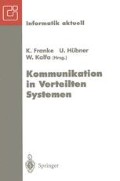Abstract
Interactive multimedia presentations are an essential issue in many advanced multimedia application tools. Before presenting multimedia data, media items, interaction types and synchronization constraints have to be specified in a multimedia document. This paper identifies and classifies the temporal interaction types in multimedia systems, and shows their impact on the specification process and the supporting system. Then, we describe how to specify the interaction types by using the standardized multimedia document language HyTime. The HyTime mechanisms are demonstrated by examples followed by a discussion of the advantages and limits of each technique.
Access this chapter
Tax calculation will be finalised at checkout
Purchases are for personal use only
Preview
Unable to display preview. Download preview PDF.
References
D. P. Anderson and G. Homsy. A Continuous Media I/O Server and Its Synchronisation Mechanism. IEEE Computer, pages 51–57, 10 1991.
Computer Inc. Apple. QuickTime Developer’s Guide. Developer technical Publications, 1991.
G. Blakowski, J. Huebel, and U. Langrehr. Tools for Specifying and Executing Synchronised Multimedia Presentations. 2nd. Intl. Workshop on Network and Operating System Support for Digital Audio and Video, Heidelberg, 11 1991.
J. F. Buford, L. Rutledge, and J.L. Rutledge. Integrating Object-Oriented Scripting Languages with HyTime. In IEEE 1st Intl. Conference on Multimedia Computing and Systems, Boston, pages 456–462. p, 5 1994.
M.Cecilia Buchanan and Polle T. Zellweger. Automatic Temporal Layout Mechanisms. In ACM 1st Intl. Conference on Multimedia, Anaheim, pages 341 – 350, 8 1993.
Robert Erfle. HyTime as the Multimedia Document Model of Choice. In IEEE 1st Intl. Conference on Multimedia Computing and Systems, Boston, pages 445–454, 5 1994.
Charles F. Goldfarb. HyTime: A standard for structured hypermedia interchange. IEEE Computer, pages 81–84, 8 1991.
HyTime. Information technology — Hypermedia/Time-based Structuring Language (HyTime). ISO/IEC DIS 10744, 8 1992.
Kaleida. Kaleida, ScriptX, and the Multimedia Market. Kaleida Labs Inc., 1945 Charstom Road, Mountain View, USA CA94043, 1993.
John F. Koegel, LloyedW. Rutledge, John L. Rutledge, and Can Keshin. HyOctane: A HyTime Engine for an MMIS. In ACM 1st Intl. Conference on Multimedia, Anaheim, pages 129–136, 6 1993.
Leslie Lamport. Time, Clocks and the Ordering of Events in a Distributed System. Communications of the ACM, 21(7):558–565, 7 1978.
T. D. C. Little and A. Ghafoor. Synchronization and Storage Models for Multimedia Objects. IEEE Journal on Selected Areas in Communications, 8(3):413–427, 3 1990.
ISO/IEC/WD MHEG. Information Technology — Coded Representation of Multimedia and Hypermedia Information Objects. Working Draft 5, ISO/IEC, 3 1992.
Steven R. Newcomb, Neill A. Kipp, and Victoria T. Newcomb. “Hytime”, The Hypermedia/Time-based Document Structuring Language. Communications of the ACM, pages 67–83, 11 1991.
Kurt Rothermel and Tobias Helbig. Clock Hierarchies: An Abstraction for Grouping and Controlling Media Streams. Technical Report 2, Universitaet Stuttgart, 4 1994.
Thomas Wahl and Kurt Rothermel. Representing Time in Multimedia Systems. In IEEE 1st Intl. Conference on Multimedia Computing and Systems, Boston, pages 538–543, 5 1994.
Author information
Authors and Affiliations
Editor information
Editors and Affiliations
Rights and permissions
Copyright information
© 1995 Springer-Verlag Berlin Heidelberg
About this paper
Cite this paper
Wirag, S., Rothermel, K., Wahl, T. (1995). Modelling Interaction with HyTime. In: Franke, K., Hübner, U., Kalfa, W. (eds) Kommunikation in Verteilten Systemen. Informatik aktuell. Springer, Berlin, Heidelberg. https://doi.org/10.1007/978-3-642-79561-9_15
Download citation
DOI: https://doi.org/10.1007/978-3-642-79561-9_15
Publisher Name: Springer, Berlin, Heidelberg
Print ISBN: 978-3-540-58960-0
Online ISBN: 978-3-642-79561-9
eBook Packages: Springer Book Archive

